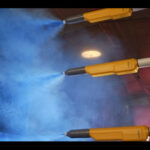The Art of Hand-Forged Furniture: A Blend of Craftsmanship and Industrial Design
In today’s world of mass production, there’s something undeniably captivating about hand-forged furniture. Each piece tells a story, shaped by the hands of skilled artisans, blending the strength of raw materials with a touch of industrial elegance. This style is where tradition meets modernity, and every piece exudes character, making it an excellent choice for those who appreciate both craftsmanship and functionality.
The Beauty of Hand-Forged Craftsmanship
Unlike furniture that rolls off an assembly line, hand-forged items are created one at a time, ensuring that no two pieces are exactly alike. This uniqueness is what makes them special. The process begins with raw materials like steel, iron, or wood, which are shaped, welded, and hammered into form by artisans who have mastered the techniques of forging. Each strike of the hammer adds texture, personality, and a sense of authenticity.
The materials often bear marks of their transformation, such as slight variations in texture or color, which contribute to the rustic charm that makes hand-forged furniture stand out. Whether it’s a chair, sofa, or table, these imperfections are not flaws—they are a testament to the handmade nature of the piece, providing warmth and individuality.
Merging Industrial Design with Rustic Appeal
Hand-forged furniture effortlessly blends industrial design elements with a rustic, country-style aesthetic. Think of West Elm-inspired pieces that combine sleek lines with the rugged appeal of natural materials. The fusion of raw metal and reclaimed wood creates a harmonious balance between industrial strength and natural beauty. It’s this juxtaposition that makes hand-forged furniture so versatile, fitting seamlessly into a variety of interior styles, from urban lofts to cozy farmhouse settings.
Furniture like hand-forged dining tables or sturdy steel-framed chairs offers both functionality and durability, while still providing an artistic element. Industrial design highlights clean, uncluttered forms, but with hand-forged techniques, the furniture also has a warmth and tactile feel that makes each piece inviting and unique.
Virtual Engineering Meets Tradition
In today’s digital age, the art of forging furniture is also evolving. Virtual engineering tools allow designers to map out intricate details before a single piece of metal is touched. This ensures precision and helps to merge traditional craftsmanship with modern technological advancements. Through virtual modeling, designers can achieve ideal proportions and refine every curve or angle, allowing for custom furniture designs that are tailored to exact specifications.
While the craftsmanship of forging will always remain at the heart of this process, virtual engineering allows artisans to explore more complex shapes and designs, pushing the boundaries of what’s possible with hand-forged furniture.
Why Choose Hand-Forged Furniture?
-
Durability: Hand-forged furniture is built to last. The use of high-quality, robust materials ensures that each piece can withstand the test of time, making it a smart investment.
-
Uniqueness: No two hand-forged pieces are the same. Each item is custom-made with its own character and personality, adding a distinct, one-of-a-kind touch to your home.
-
Timeless Appeal: Whether it’s a statement table or a subtle chair, hand-forged furniture has a timeless quality that fits seamlessly with both modern and traditional interiors.
-
Sustainability: Many artisans use recycled or reclaimed materials, contributing to more sustainable and eco-friendly practices in furniture making.

